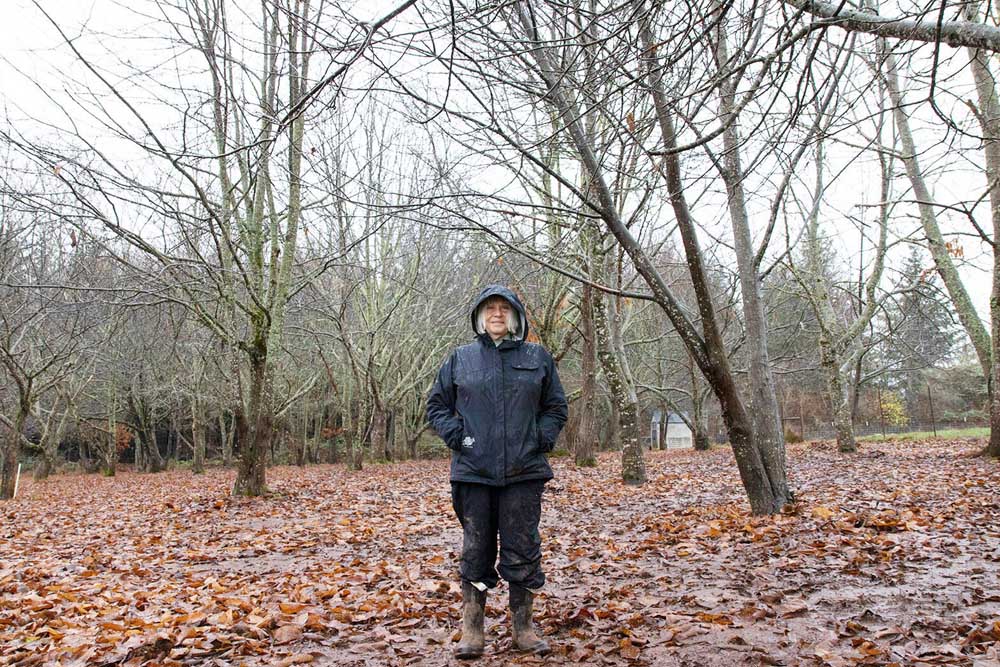Sweet Home farm keeps chestnut industry alive
Published 8:30 am Friday, December 17, 2021

- Carol Porter stands in her chestnut orchard.
SWEET HOME — Carol Porter recalls sitting in a doctor’s office in the mid-1980s, flipping through National Geographic, when she came across a story on chestnuts.
The article brought back childhood memories. Her parents, Italian immigrants, had exposed her to roasted chestnuts and sweetbreads made with chestnut flour when she was little. Porter said she wondered if she could plant an orchard.
It would be a big change of pace; Porter and her husband, now deceased, were cattle ranchers, riding horseback often 20 miles a day on Colorado ranges.
“This was altogether different,” said Porter, 79.
The couple settled in Sweet Home, where they started a grass-fed beef and pork operation and, in the early 1990s, planted a chestnut orchard.
Today, Sweet Home Chestnut Farm is one of about 10 chestnut operations in the Northwest, keeping alive the tradition of “chestnuts roasting on an open fire.”
According to Oregon State University’s Extension Service, the hardwood American chestnut grew in vast stands across the continent when early settlers arrived. The chestnuts were a staple for both settlers and many wildlife species.
Then chestnut blight, a lethal fungus infection from Asia, hit around 1900, wiping out nearly the entire population. Although the Northwest has been blight-free since the 1930s, the industry collapsed.
The chestnut industry continued strong in Europe and Asia.
In the 1990s, with federal grant funding, Oregon State University worked to re-invigorate America’s industry — perfect timing for Porter, who benefited from OSU’s research.
But Porter didn’t realize what a challenge growing chestnuts would be.
“I guess I was very naive about it,” she said.
According to OSU, chestnut trees don’t begin to bear nuts until they reach 4 or 5 years old, and Porter said the trees didn’t reach peak production until year 12. The trees should remain productive for another 100 or more years.
The trees don’t drop their chestnuts all at once, and the chestnuts must be gathered shortly after dropping, meaning harvest can last from September through mid-November.
“The trees are very individualistic,” said Porter, walking among her 173 trees. “I sort of know them all now, but they still surprise me sometimes.”
The chestnuts are multilayered: milky kernels inside brown hulls buried in spiny burrs.
Because kernels have a moisture content upward of 49%, according to the University of Michigan, they must be stored in a cooler.
Annually, Porter sells 3 to 5 tons of large chestnuts, including to the Corvallis Farmers Market and retail stores. She sells at $3.50 per pound wholesale and $6.50 per pound direct-to-consumer.
The smaller chestnuts she feeds to her livestock. She sells her pigs as “chestnut-finished pork,” a finishing process that sweetens the meat.
Chestnuts, Porter said, mildly sweet and nutty, can be eaten many ways: with pot roast, buttered and baked with rosemary, ground into flour, coated in brandy and powdered sugar, dipped in rum and chocolate or plain-roasted.
”There’s something about them that’s very endearing,” said Porter.
Though the work has been hard, Porter said she’s glad she did it.
“If nothing more, it’s a conversational piece: ‘You do what?’”
Porter’s niece and nephew are interested in carrying the chestnut business forward, so Porter has a succession plan to pass on the farm, keeping Oregon’s industry alive.






